I traveled to Nashville for the first time in 2007, spending most of my time in the downtown area. I posted my impressions here, noting the high growth and high ambition level as well as the fantastic freeways, but also the generally unimpressive development and built environment.
I did another fly-by in April of this year. I made a conscious effort to try to get out and see different areas this time around. My tour guide was an Indy native who had spent the last decade or so in the northeast. He’d moved to the city about a year previously, so was seeing some of this for the first time himself. But it worked well, I thought.
I believe Nashville is an extremely important case study for metros in the Midwest to examine. Here is a city that was a sleepy state capital for many years while other southern towns such as Atlanta and Charlotte took off. Then it began heading on an upwards trajectory. It is not yet at such a high growth rate that it appears to be a completely different sort of place than the Midwest. It’s population growth is only 1.9% per year, for example, not much higher than Midwest growth champion Indianapolis at 1.5%. But all the trend lines are accelerating. Corporate headquarters are flocking, in city development is booming, transplants from the north are arriving. It would not surprise me to see this city pop into a higher gear when the economy turns upwards again.
Nashville is a great case study because we can observe the inflection point in growth more or less as it happens. And also try to make sense of what is driving it. And to understand why Midwestern cities aren’t seeing it. I look at Nashville and ask myself: what does this place have on the Midwest? Compare it to Columbus, Cincinnati, Indianapolis, Louisville, Kansas City, and Milwaukee and see if anything jumps out that would explain it. Some unique factor of Nashville. Consider:
- Nashville is smaller than most of those places today, so it isn’t size
- It can’t be just because Nashville is in the south. Memphis in the same state and is hurting. Birmingham remains a sleepy place.
- It’s college degree attainment of 28.3% is below many comparable Midwest cities
- It has no particular unique industry or assets. It can cite its Music City USA image, which certainly drives tourism and money. But Midwestern cities have other equivalent things they can counter with. Plus, it was Music City USA all the time it was a sleepy state capital as well.
- Just being the state capital doesn’t explain it. Indy and Columbus are both in that role and are getting out paced by Nashville.
- Having a consolidated city-county government is not unique. Indy and Louisville are both consolidated, and Columbus is quasi-consolidated because of the ability of that city to annex most of Franklin County and even parts of several adjacent counties.
- There are mountains, but the geography does not appear to be particularly compelling.
- There are not fabulous historic districts in every region. In fact, while there are some nicer neighborhoods, much of the city is built out exactly like most Midwestern burgs of equivalent size. A lot of it is outright dumpy.
- There’s additional “culture shock” for northerners to get used to when the transition, the southern drawl, smoking in restaurants, etc.
- It’s cultural institutions are not as advanced as Midwestern ones. The Nashville Symphony isn’t going to take on the Cincinnati Symphony any time soon, that’s for sure.
- It doesn’t have some fortress home growth companies that are driving it.
- It has Vanderbilt University, but most Midwestern cities have a good school in them too.
I compare Nashville to the top performing Midwest metros and just scratch my head. Nashville’s arguably got nothing on the Midwest and in many ways is playing from an inferior position. So what is going on?
I’ll take a shot at explaining a few things I’ve noticed. I’m not saying these are necessarily the answers. But they are things to consider. If I were head of strategy for a Midwestern metro, I’d be conducting an extensive peer city comparison of Nashville to try to figure it out in more detail. But here are some thoughts:
- First, as I previously noted, is the extremely high ambition level. These guys are clearly looking at places like Atlanta, Dallas, Charlotte, etc. and saying “Why not us?” Their mission is to become one of America’s great cities. There’s no “era of limits” in Nashville. You see this come through, for example, in their convention center plans, which call for 1.2 million square feet. It comes through in their highways, which are being built 8-10 lanes with HOV lanes, as if getting ready to become the much bigger city they plan to be. It shows in the numerous residential high rise and midrise projects. It shows in how Nashville, unlike every comparable Midwest metro, already has a commuter rail line in service. Midwesterners recoil from change, and would view becoming the next Charlotte or Atlanta with horror. But Nashville is eager to move up to the premier league, so to speak.
- Second is the unabashedly pro-growth and pro-business stance. Every development in the Midwest is opposed by some group of NIMBY’s. Densification, even in downtown areas, is often anathema to influential neighbors. Not in Nashville. Huge tracts of inner city are being rebuilt from vacant lots or single family homes into multi-story town houses or condos. There are midrises all over the place. It does not appear that development has any problem getting approved there.
- Third is low taxes and costs. Tennessee does not have a state income tax. Electricity from the TVA is dirt cheap. Property taxes cannot be increased without a public vote. It remains to be seen if this environment can be sustained, but for right now, cost appears to be an advantage.
- Fourth is that they’ve embraced instead of rejecting their heritage. Rather than saying that country music is for hillbillies and an embarrassment to their new ambitions as a big league city, they’ve proudly embraced it. They updated the image with a glitzy, “Nashvegas” spin and made it the core of what Nashville is all about. Most Midwestern elites seem to view their existing heritage negatively. But great cities have to spring from the native soil in which they are born. Their character has to be organic. Import all the fancy stores, restaurants, sports teams, transit lines, etc. you want, but it won’t distinguish your city. Nashville learned this lesson well, probably from Atlanta. The southern boomtowns took their existing Southern heritage, dropped the negative items that needed to be changed, updated the core positive elements, and created the vision of the “New South”. This is something that can be embraced by the masses, unlike the elitist transformations that are often promulgated.
- Fifth is that, again, they appear to have studied the lessons of places like Dallas, Atlanta, Charlotte, etc. They’ve seen the need for freeways. They’ve looked at the style of development and the neo-traditional urban form. I was very impressed to see that there while most condo developments and such were fairly undistinctive, I did not note any that exhibited poor urban design form. When I consider the poorly designed projects that are frequently implemented in, say, downtown Indianapolis, it is easy to see who gets out more. Nashville has done its homework.
- Sixth, Nashville is realistic and open to self-criticism without being self-flagellating. I posted my previous take on the city on a discussion forum dedicated to that city. Given the modestly negative tone contained in much of it, I expected to get crucified. Surprisingly, most of them basically agreed with it. Too many cities in the Midwest either engage in naive boosterism or wallow in woe-is-us. Perhaps because of the large number of newcomers, there’s a more realistic assessment of where Nashville stands. And this enables rational decisions about where it needs to go.
If anyone else has observations to share, I would love to hear them.
Here are some photographs I took while there. First, a view of the Tennessee capitol building across a green space I believe is called the Bicentennial Mall.
A street scape in Hillsboro Village, a small commercial district near Vanderbilt University.
The Pancake Pantry in Hillsboro Village, a breakfast place of high local repute. I was initially skeptical but the food was actually pretty darn good. This place is huge and there was still a line out the door at 10am on a Friday morning. Pretty crazy.
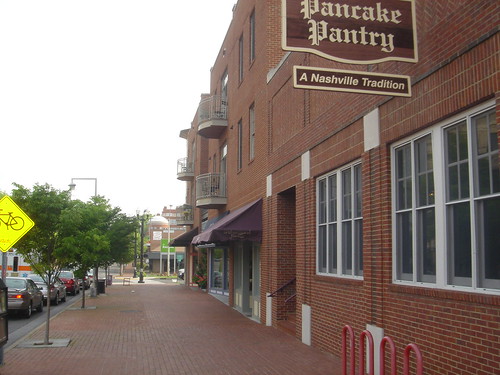
The storefronts are a nice urban touch, but if you look behind this building you see a gigantic parking lot. This is perhaps an example of faux-urbanism. Putting the parking lot in the back doesn’t make it any less a strip mall. It is a difference in form, not function.
One of the many vacant lots with a “condos coming soon” sign.
The main road heading west of out downtown, West End Avenue, is developed at very high densities. I haven’t seen much in the way of this in most Midwestern cities. Midrises line both sides of the road basically from downtown to the interstate loop. It’s a six lane mega-street that moves tons of cars, but appears to have great bus service as well.
Here is another one under construction.
A proposed, but I believe not yet funded, high rise development. Indianapolis readers will no doubt recognize one of the towers as a clone of the proposed Intercontinental hotel for Pan Am Plaza that lost out as the convention center anchor hotel.
If you continue out to the west from here, you run into neighborhoods like Green Hills, which is where the most premier shopping in the area is found, and the suburb of Belle Meade, which serves as Nashville’s mansion district. Unlike traditional Midwestern mansion districts, this one is more rural in nature, with large estates that wouldn’t be out of place in a plantation. I did not take pictures of these areas, however.
Back closer to downtown is a nearby area known as the “Gulch”. It is not too far from Nashville’s Union Station.
This appears to be some seedy industrial district that is being transformed all at once by a series of large developments. It also has several clubs and restaurants. I ate at a seafood place called Watermark that was surprisingly good. I believe most of the places are upscale chains, though I’m not sure if Watermark is or not. Here’s a picture of some of the development.
More development
North of downtown is a small historic district called Germantown. This was rather unimpressive if you ask me. I didn’t see much that was German about it. It sure isn’t Columbus’ German Village, that’s for sure. There were some restaurants there. I had lunch at one of them which, fortunately for them, I can’t remember the name of because it was terrible. This area is mostly older single family homes.
The amazing thing about this area is that almost every vacant or industrial parcel was being redeveloped as condos. This really brought home to me the difference between Nashville and the Midwest. Were this, say, the Cottage Home area in Indianapolis, the local neighborhood association would use their historic district status to keep developments like these out. In Nashville, they are seen as a positive. Here are some examples.
More condos
More condos with retail space. Sorry for the very blurry pic but it was raining as you can see.
More condos being built, and still more proposed.
You get the picture. Also, note from all these photos the lack of design disasters. These are all workmanlike structures. The challenge for Nashville is that while there is a ton of new development, all of it is in a relatively generic, undistinguished style that could be in the downtown of almost any city. I did not get a strong sense of any type of vernacular style emerging. That is something I’d be looking for if I were them.
Lastly, here’s one suburban example that shows something I pointed out last time. Namely that even in brand new, upscale subdivisions they aren’t putting in sidewalks on both sides of the street. I find this very odd. While I noticed some bike lanes this time around, Nashville’s definitely got a long ways to go when it comes to pedestrian and bicycle friendliness.
Nashville is definitely a city that is on an upward trajectory. The volume of urban development and the business attraction success are impressive. It is exceeding even the best performing Midwest metros in that regard. However, it still lags the top southern and western metros. The current rate is very healthy, but probably isn’t sufficient to realize the civic ambitions. It remains to be seen whether Nashville can put it in another gear and take its place among the boomtowns, or whether it will merely stay on its current growth path. Either path is possible or a valid civic choice. While always possible, the likelihood that Nashville is going to take a major downtown does not appear high in the short term.

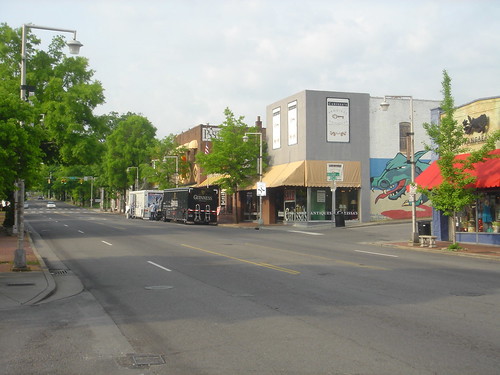
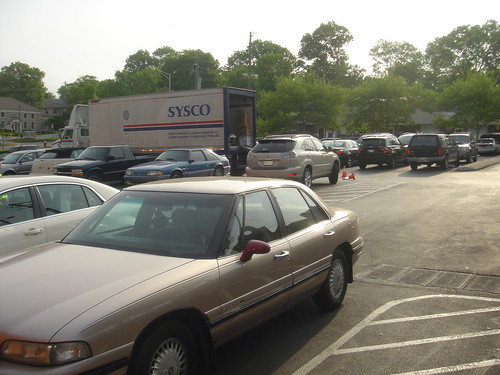


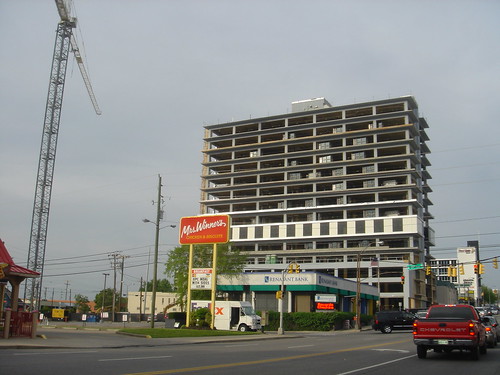
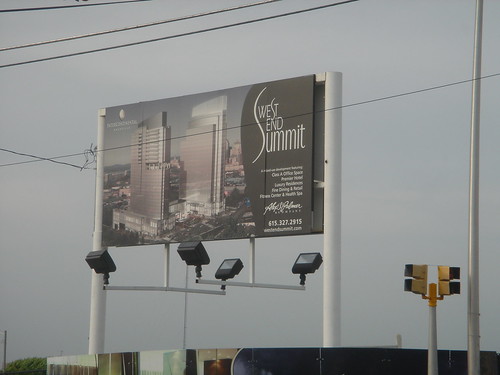

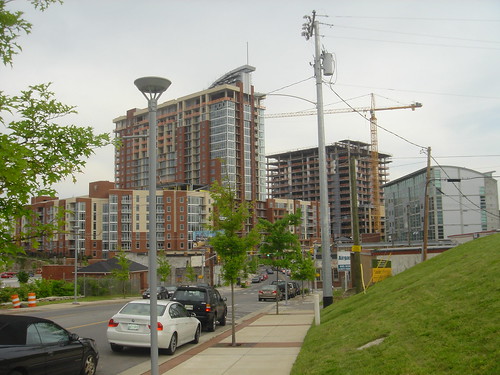
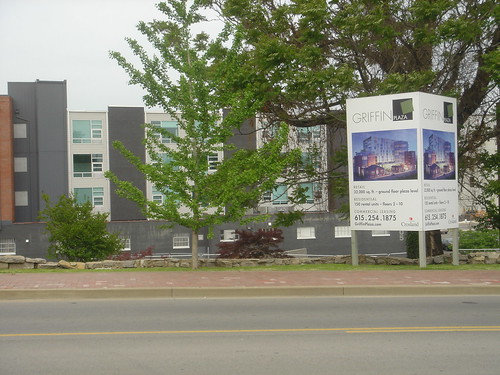
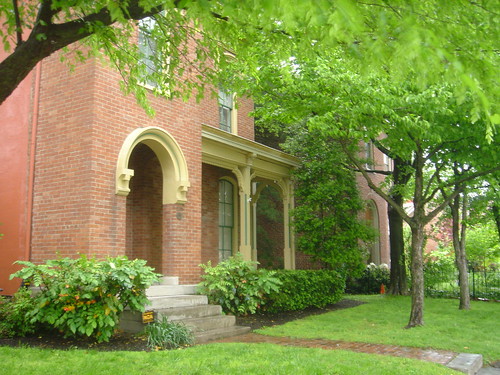



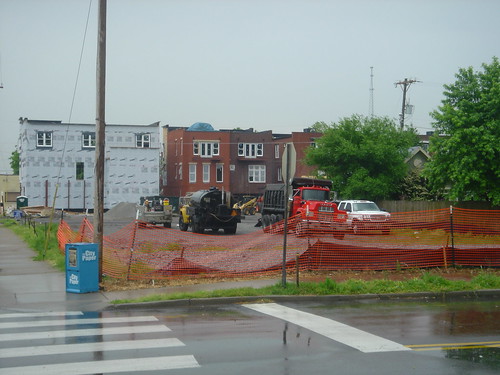
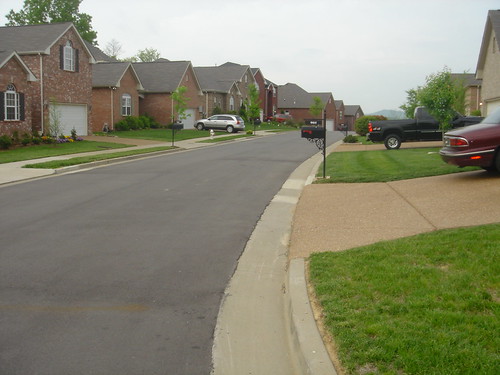
I wouldn’t underestimate the Music City image Nashville has. It attracts plenty of national attention from the recording industry there, as well as nationally from CTV and shows like “Nashville Star”. Stuff like that, combined with incredible attractions like the Opreyland, are what brings people to the city. The city also doesn’t have the stigma that Memphis has as far as crime goes…I’m sure the fact that Memphis is mentioned in a lot of big city crime rankings deters business relocations. All in all, Nashville sets itself apartfrom the start as a more “interesting” place to be.
You’re definitely right about one thing though, it seems as if there’s much more of a pro-business climate there. In Indy, it seems like people have to jump through too many hoops to get things done. Of course, it always helps when there’s the market demand for all these developments. In Downtown Indy, you’ve got a glut of condos sitting on the market right now from a few small size projects getting done. It should be interesting to see how Nashville looks in 2020.
On the topic of Nashville, I’m assuming the Signature Tower is in danger of cancellation? The thought that such a project was even proposed further strengthens the argument you gave.
Birmingham isn’t a state capital. The capital of Alabama is Montgomery.
You’re right – very stupid of me.
Babbage, why do you think it is that there’s a greater market for downtown condos in Nashville than Indy? That’s the sort of question that should be investigated.
Signature Tower is unfunded, which means indefinitely shelved in this market. My understanding is that they are trying to re-work the design to incorporate more office space in order to get the project off the ground.
Urbanophile, I think it could be as simple as climate mixed with the cheap electricity.
The overwhelming demographic trend for 30 years in this country has been to warmer places (and the mountain west).
Cheap electricity makes running a heat pump cheap no matter what time of year it is.
thunder, I won’t discount that, but it seems like a bit of a cop out to me. Lots of places have cheap electricity and/or are in the south and have not done well. Blaming the climate and electricity reinforces the fatalistic Midwestern attitude that says we are victims of circumstance, that the success of other places resides in factors we could never emulate no matter what we did. It’s certainly possible that’s true. I certainly believe the low tax, low cost, low regulation environment of the South has a big role to play. But I also believe there’s no reason why any number of Midwestern metros couldn’t turn it on to a more high growth trajectory. The story has yet to be written and it can’t be proven at this point. But I believe the potential is there. Minneapolis is probably the closest right now.
Not really being familiar with too many of the cities cited, maybe it is because there is less “crap” there?
By that I mean…when tooling around a city, you see something distasteful and say, “Wow, that’s crap. Who built/designed/approved that?”
Whenever I’m in Indy…everything drives me nuts–the incredibly long signal timings (in LA they turn fairly quickly), no one directing traffic when a signal loses power and no temporary stop sign in place either, etc.
Looking at the pictures, it looks aesthetically pleasing, if a little bland at times.
Regarding Indianapolis, it feels like they really do not miss an opportunity to miss an opportunity. Look at Broad Ripple. One of the highlights of Indianapolis to be sure…but how much better would it be if the canal were transformed into something like the San Antonio River Walk?
Why does Indianapolis lack buried electrical lines? Sidewalks in residential areas? curbs, gutters and storm sewers anywhere outside of the Old City Limits, pre-Unigov?
The city just feels so half-assed and compromised. I’m betting Nashville does not.
If you think the timing of signals in Indy is long, you would HATE Kansas City. It is not uncommon to sit for 2-4 minutes. I hate it.
How does the state of Tennessee pay for all of its massive freeway upgrades and huge new outer beltways if it has low taxes? Is TNDOT much better run and funded than INDOT?
Indiana’s taxes are not high. It is every bit as Republican a state as Tennessee.
The availability of cheap land and a proper attitude desiring to aspire higher play a big role in Nashville’s boom.
Nashville’s reliance on freeways and urban sprawl are in no way sustainable though. Its autocentrism will come back to haunt the city.
Urbanophile, start loading on the “other factors” and Nashville quickly steps forward.
Cheap electricity.
State capital.
Pro-development attitude.
Unique major tourist draw/national profile.
Location on a major north-south or east-west highway.
Moderate “sunbelt” climate
The other TVA cities all lack one or more of those features.
ps. I, too, wonder how they’re paying for 10-lane expressways.
Nashville’s current boom can be traced to the 80’s with the announcement that GM had selected Spring Hill for the large Saturn facility followed by American Airline’s decision to establish a hub there. What followed was the boom that resulted in present day Nashville complete with a NFL and NHL team. Nashville has also benefited from some corporate HQ relocations and it also cleaned up and polished its Music City image.
As noted in the Urbanophile posting, Nashville continues to view Atlanta and Charlotte as the city’s it most wants to be and it could one day get there. When it does, it will wish it hadn’t.
Urbanophile-
One of the things that I notice when comparing Indy to Nashville or even Charlotte is the fact that both of those cities lacked any real form old, multi-family apartment buildings that are common throughout Center Township. Certainly, there are some in those cities, but part of their construction boom is due to an absent of what has been here in Indy for 80+ years. Nashville just doesn’t have the multitude of 4-10 story apartment buildings that we have and therefore the need for highrise living is due to a lack of the product.
Charlotte is a bit different as there are so many eastcoast transplants accustomed to that type of living, so the demand is even higher.
Nashville also has some pretty high crime, a lack of sidewalks in huge swaths of the City, and numerous areas developed identical to portions of Indianapolis’ west and east sides.
urbanophile, after a brief look at some of the u/c proposed condo projects in nashville, there seems to be a much greater amount in the city.
icon condos – 22 stories
The Encore – 20 stories
Adelicia Condos – 18 stories
Terrazo – 14 stories
West end condos – 11 stories
rythm at music row – 14
then there are numerous other lowrise projects, and that’s at an old ssp construction thread.
here in indy we’ve got
3 mass – 10 stories
villagio – 9 stories
and a few lowrise projects as well and some condo portions of hotels proposed. obviously all these projects in nashville wouldn’t be moving forward if the demand wasn’t there in some way.
that, and i’ve checked the sales sites for several developers in indy over the last week for the first time in a while. either the sites haven’t been updated or condos are hardly moving off the market. it seems as if the current trend in indy is now apartments amyhow.
my point with the signature tower is that the fact that such a project was proposed in the city shows their desire to compete.
“It’s [sic] cultural institutions are not as advanced as Midwestern ones. The Nashville Symphony isn’t going to take on the Cincinnati Symphony any time soon, that’s for sure.”
Evidence? The NSO is one of the most recorded symphony orchestras in the country right now, it just won three classical Grammies, and plays in a new, state-of-the-art concert hall that’s among the most important to open in the past several years. It’s a widely respected ensemble, and one that’s much more financially stable than Cincinnati, which has been in difficulty for years.
Another point; you say that Nashville has no distinctive industries, but in fact music is an industry, and several recent studies of the economic geography of the music industry [including one by creative-class maven Richard Florida] place Nashville as comparable only to New York and Los Angeles in its concentration on music. The city is also a major center for the health-care management industry, and has long been a publishing center [notably religious].
And, finally, Watermark is independent; why are you surprised that it’s good?
I visited Nashville for a week back in 2003. While it has a lot of potential, the first thing that comes to mind is – SPRAWLTOWN. TennDOT is completing Route 840, a huge southern beltway of the metropolitan area, radiating far, far from the City than I-465. There really seems to be no justification for the road except economic development. However, that development, I fear, will come at the cost of central Nashville.
The reliance on autos in Nashville may lead to its doom. I do have a couple of questions though – where are the job clusters in Nashville? Does mostly everyone in the ‘burbs commute downtown? I haven’t noticed any so-called edge cities that have developed thus far in Nashville.
Nashville is absolutely becoming a little Atlanta in terms of sprawl. Traffic is horrible, mostly because of the topography which makes a lack of east/west roads and a lot of congestion. Also, there hasn’t really been an ‘edge city’ type of office center until the recent rise of Cool Springs. So, you have most traffic heading downtown – probably helps dt residential also.
I would also agree that you can’t count out the economic impact of the music industry. If you think about it, country music as an industry has grown along with the city. These aren’t the days of Randy Travis anymore. Country music is a huge business and a lot ‘cooler’ than it used to be.
Finally, I think Nashville has a lot more character than a city like Indianapolis. Stretching from downtown through Vandy and out towards the Green Hills area is a mix of cool, trendy shops and restaurants. Why else would someone as cool as Jack White move there.
Finally, the state almost went bankrupt a couple years ago because of their lack of sales tax so it isn’t all perfect.
I grew up near Nashville and have a couple of thoughts about its development.
1. As others have pointed out, the music industry in Nashville is not a quaint historical curiosity that the city has embraced to create an identity; it is a modern multi-billion dollar industry. And while country is the primary focus, there are a lot of indy and rock bands that are also based in (or produce and record in) Nashville because the studios and people with the know how are there.
2. Vanderbilt is a good school and brings in a lot of talent; its medical center is also very good. Plus, it has a great location; it’s right by Hillsboro village and West End.
3. Sprawl – traffic is horrible in Nashville, much much worse than anything in Indy. Although more people live in Nashville than previously, it is very common for people to live far outside Nashville and commute in – although I assume with its traffic and gas prices increasing, this is going to change.
“Finally, I think Nashville has a lot more character than a city like Indianapolis.”
Well thats not really saying much. Indy’s got Broad Ripple which is a couple blocks and thats about it.
How does TDOT pay for roads? TN is a ‘pay as you go’ state. Road projects are paid with cash, so no debt maintenance is required
Indy has only Broad Ripple? Um, I’d beg to differ. There are many interesting, older neighborhoods in and around Indy which posess a lot of character. You must not be too familiar with Indy outside of Broad Ripple……
Indy has plenty of old neighborhoods…but Broad Ripple is the only one that comes to my mind as being one with much character.
Sure, Indianapolis has a lot of old neighborhoods, but how many of them are just residential? Broad Ripple is the only real “complete” neighborhood with a lot of character to it…Nora is complete, but it’s all strip malls and large parking lots.
Carmel’s Old Town is complete and has a lot of character to it, but that’s in Carmel.
There just aren’t very many places in Indianapolis that I’d like to just walk around. There’s either nothing to walk to, or there’s stuff that’s frankly junky and/or generic.
Thanks for the comments, everybody.
Regarding buried electric lines, very few cities do this on arterial streets. Even Chicago, which has some of the most beautiful power line free streets in America, uses above ground lines in alleys outside of downtown. The truth is, the vast bulk of neighborhood streets in Indy don’t have power lines. But the main arterials do and alas that is all anyone sees.
Cory, interesting take on the lack of alternate supply of urban housing as potentially driving things.
Regarding character, the character of a city is in its people, not its buildings. As I noted with Cincinnati, all the great natural and built environment in the world isn’t enough. Indy is pretty close behind Nashville in population growth and is the Midwestern champ. So it must be doing something right itself.
GEESH, after 6 years on these blogs/forums, the inevitable “Indy has no good neighborhoods” comment appears. Indy has much more than just BroadRipple as a “complete” neighborhood. Meridian-Kessler, Irvington and Butler-Tarkington are fine examples of street-car suburbs with very strong housing and commerical stock. Closer to downtown you have the wonderful Old Northside, Chatham Arch/Mass Ave and Herron-Morton. Also complete with commerical nodes dating to the 1920’s. Finally, the recent Fall Crewek Place project has been a smashing success with new commercial popping up there all the time.
The people who claim that there are no good neighborhoods obviously “drive-thru” Indy or spend their time downtown. Yes, Indy is downtown-focused, but you can’t be a suburb/exurb of nothing…you have to have a strong central city. I implore those who make the claim to actually do some research. You can’t be a City the size of Indy, with a huge portion of your initial growth centered around the railroad and not have good, strong neighborhoods. It’s not possible.
Nashville has an incredible Planning Director who is a national leader in New Urbanism. Does Indy even have a real planning department?
The planners I’ve met are certainly real, if not always realistic. 🙂
Its so so sad how people stick up for Indy’s pathetic state of affairs. I have a job in Portland (a REAL urban city) that I will be leaving for in the fall. I will definitely miss my family and some friends, I will absolutely not miss the unrelenting NIMBYness of the residents of this city.
Hey CoryW–your comment is really interesting because one of the neighborhoods you claim to be “complete” is the neighborhood I live in, and it most certainly isn’t. I am a long-time resident of Meridian-Kessler, and am therefore very familiar with both it and Butler-Tarkington. These neighborhoods are virtually all residential, and therefore not “complete.”
Yes, the housing stock is fantastic, and IMO contains some of the best architectural quality in the state, the commercial stock is so limited and niched that it might as well not be there. Where are the neighborhood commercial nodes? College Ave. and Kessler, 54th, 52nd, 49th, 46th. 49th and Pennsylvania. The north side of 38th St.
That’s all that exists in M-K. The Pharmacy at 49th and Penn. just went out, as did the Friendly Foods convenience store. The replacements? A hair salon and an expanded cafe patachou. There’s a dry cleaners, a gift shop, tcby, a bank, two realty co’s, a hardware store and a dog bakery. Of these, the bank and hardware store are the only ones that are all that useful for everyday needs. Yes, there is a gas station there too, but duh, who cares if you can walk to a gas station?
The nodes on College all contain the same smattering of eateries and random retail stores. One exception: 54th and College now has a real grocery again. Bout time. There’s a gardening store at 52nd and College.
The main issue with M-K and its “commercial nodes” are that there are too few of them, they tend to be located along the fringes of the neighborhood (hindering walkabillity for most of the neighborhood) and the vast majority of them do not contain useful items for day-to-day life. I really do not need a picture frame store within walking distance, but I’d kill for a grocery and pharmacy.
Luckily for me, the much more useful node in Butler-Tarkington at 56th and Illinois is only a few blocks from me. But it’s too far for the vast majority of the neighborhood, and there are no sidewalks along 56th St, or in a surprising amount of B-T either. Please enlighten me if I’ve forgotten another B-T commercial node, but I’m drawing a blank. The one at 42nd and Boulevard is pretty much abandoned, so I’m not counting that.
Where is the completeness of M-K and Butler-Tarkington? As a long-time esident, it isn’t there, and with the lack of sidewalks along some streets, there’s no way it can be compared to Broad Ripple.
This post is getting long, so I’ll respond to Fall Creek Place briefly: FCP lacks character as the new housing structures are row upon row of the same building with different color schemes, or maybe in a mirror image of its neighbor. The old homes that were left to rot and become demolished had far more character than any of the stuff they are building there now.
THAT SAID–I like the concept of FCP and think overall it is an improvement to the area. Is it a complete neighborhood, though? Hell no. The commercial nodes again do not satisfy daily needs. There are also very few of them.
One thing that I learned is that Nashville has a form based zoning ordinance. This is probably responsible for the quality urban design.
From the Urban Dictionary:
1. The Ville 106 up, 70 down
The Ville is a ghetto fabulous term for the city of Roseville, Michigan. It can also be used for pretty much any other city that has ville in it. However, this term is specifically meant for Roseville, for reasons that I will explain further down in my definition.
In regards to Roseville, anyone with an ounce of coolness can clearly see that the actual city name isn’t very hip. It doesn’t strike fear into those that hear it. People often associate Roseville with roses, or possibly some other device of cuteness, such as a fairy or a unicorn. These things aren’t very funky fresh or jive like.
In contrast, The Ville strikes fear into those that hear its name. In other words, it is the funkified version of Roseville. The Ville is often associated with poppin fresh coolness and other hella hip terms.
Well the HOV lanes in Nashville are pretty much worthless as they don’t have dedicated on ramps or exits.
That pretty much defeats the purpose of a HOV lane, especially in a traffic jam.
It is imposssible to talk about Nashville without talking about its incredibly low taxes including no state income tax and very low property taxes. The entire state of Tennessee has low business taxes that even put Alabama to shame.
Think about it, the City of Nashville is not on an Ocean, isn’t particularly warmer than the Cities east of it on the coast, there isn’t much geographically unique about it. Sure, the rolling hills are pretty but every City/area tends to have SOMETHING that is appealing (except for the flatlands of IL).
No state income tax = entrepeneurial climate = attraction of wealthy individuals = attraction of corporations and jobs.
I guess the biggest difference between Nashville and Memphis is the lack of poverty in Nashville, the much lower crime (Nashville is a much newer City without a huge urban ghetto dragging it down) and its existence in the pro business state of Tennessee. The fact that its Music City or the Tennessee Titans call it home doesn’t hurt its image either.
Growth begets more growth.
"I certainly believe the low tax, low cost, low regulation environment of the South has a big role to play."
Agreed. I just hope all the hella-hip and cool trend setters moving in from everywhere else never forget what drove them out of their former homes in the first place. Nearly every other city you describe has been run by big-government spending and regulatory types. The results speak for themselves. Need we even discuss the entire state of California and the planners who made it that way?
As good as things are in the Music City, I fear that in a few years the newcomers will be voting for the exact same kind of high taxes, bloated government programs, restrictive zoning and land use laws that will do nothing but turn Nashville into an expensive Memphis. Don't let it happen!